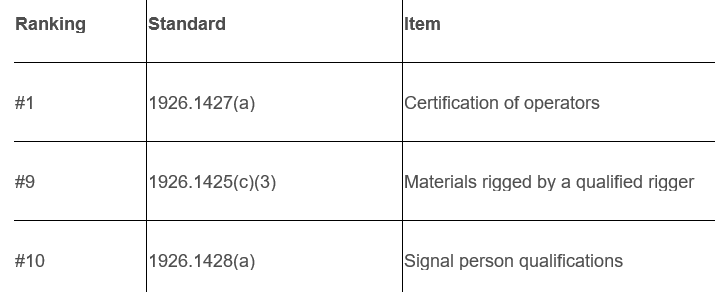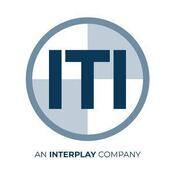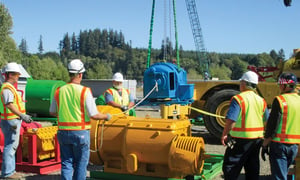The Occupational Safety and Health Administration (OSHA) recently released a new compliance directive CPL 02-01-063 for cranes and derricks. This directive replaces the 2014 compliance directive CPL 02-01-057 and addresses the changes in the crane rule that OSHA made in 2018. This new compliance directive only revises the existing section on operator training, certification, and evaluation, leaving the other sections of the 2014 directive unchanged.
The primary focus areas of the compliance directive include:
- When to initiate an inspection into an operator’s training, certification, and evaluation
- How to approach an inspection involving multi-purpose equipment and multi-employer worksites
- How to determine whether the operator has received training that meets the requirements of the standard
- What steps to take when inspecting the certification/license of an operator
- How to address certification concerns such as fraudulent certifications or testing organizations not meeting requirements
- When an employer would need to conduct additional evaluations for an operator
While compliance directives provide OSHA enforcement personnel with guidance on conducting inspections and policy on citing violations of the standard, the guidance and explanation can be helpful for employers.
At the NCCCO Foundation Industry Forum held in November 2021, OSHA provided the top 10 citations for cranes in construction for 2020-2021. Of these, three are related to the certification/qualification process for personnel.

The 2018 crane rule from OSHA provided a framework for establishing operator competency for the construction industry. The operator must be: Trained + Certified/Licensed + Evaluated = Qualified.
Help your team avoid the above citations by taking one or more of the following ITI courses:
ITI Mobile Crane Operator Training Solutions:
- Mobile Crane Operator - Initial | 5 days, in-person course
- Mobile Crane Operator - Qualified| 5 days, in-person course
- NCCCO Mobile Crane Operator Certification Test Prep | 3 days, in-person course
ITI Master Rigger Training Solutions:
- Master Rigger | 4 days, in-person course
ITI Signal person Training Solutions:
- Signal person Certification Test Prep | 3 hours, online course (exams offered separately)
- NCCCO Signal person Prep | 2 days, in-person course
- NCCCO Practical Exam for Signal person | in-person exam
- NCCCO Written Exam for Signal person | Offered at ITI Training Centers and Approved Computer-Based Testing Locations
- Qualified Signal person Exams | 1 day, in-person exam
Operator-In-Training
Operator-in-training allows the operator to continue operating cranes when they are not yet certified/licensed or evaluated as required, but in such cases the operation must be under supervision of a trainer. OSHA expects there to be a continuous cycle of training, certification, and evaluation.
While the standard does not require employers to create and maintain training records, Compliance Officers are directed to ask for training records, program materials, and interview the employer and employees to determine what training was provided.
OSHA states that employers have a continuing duty to monitor the performance of their operators to determine whether retraining is necessary.
The ITI Learning Hub makes is easy to manage and maintain employee training records. Learn more about how we can help you keep track of learner transcripts and certificates by scheduling a demo with one of our specialist today.
Operator Certification/License
Once a determination is made that the equipment operated is within the scope of the rule (see 1926.1400) and that none of the exceptions of 1926.1427(a) apply, there are essentially four key questions on the flowchart provided by OSHA in the directive:
- Is the operator certified/licensed?
- Was the certification/license issued by an accredited testing organization, an audited employer program, or compliant state or local government licensing program?
- Is the certification/license within the expiration period established by the issuing entity and has not exceeded 5 years since it was issued?
- Is the type of crane operated the same as, or similar to, that specified by the certification/license?
Verification of the status of a certification body, such as CCO, has been made easy by the NCCCO Foundation which has published a “Who’s Accredited?” Directory that is kept up to date. For operator’s certification details – which must be available to OSHA upon request – CCO recommends that entities utilize the Verify CCO Online (VCO) system to access CCO’s database for the most current information.
Operator Evaluation
As a new requirement, the 2018 crane rule requires that employer must document the completion of the evaluation in accordance with 1926.1427(f)(6) and make the document available at the worksite for as long as the employer employs the operator. The employer is required to document the following information:
- Operator’s name
- Evaluator’s name and signature
- Date the evaluation was completed
- Make, model, and configuration of the crane(s) that the operator can safely operate for construction task
Within the flowchart for crane operator evaluation, the key elements are:
- “Has the operator been evaluated on the assigned equipment?”
- “Did the employer determine the evaluator is competent?” (If yes, please document)
- “Did the evaluator determine the operator is competent to operate a crane which is similar to that assigned, and for a task similar to that assigned?”
- “Does the required evaluation documentation include at least the six pieces of information specified?”
Looking Forward
OSHA will be releasing the revised Small Entity Compliance Guide and Frequently Asked Questions related to this final part of the rule. In the last cycle these documents were released within a few months of the Compliance Directive.
About ITI
Industrial Training International (ITI) is a global leader in the design and delivery of learning solutions for organizations conducting crane, rigging, and load handling activities. Founded in 1986, the company originally specialized in instructor-led training, field services, and consulting. ITI has since grown to also produce live online, and on-demand courses delivered via the ITI Learning Hub and has been recognized with numerous industry association awards for its groundbreaking virtual reality crane and equipment simulations solution. For more information about ITI, visit www.iti.com.




COMMENTS